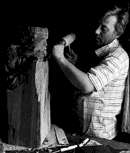The show at the Academia deli Intronati puts the visitor into a favourable mood, especially if the latter is a woman. Nino Gorni, a painter from Brescia, presents his pictures of many characteristic glimpses of ancient villages and studies of faces. Two walls of the hall are covered with paintings done with mixed technique. A prominent part is the roundup of female figures as homage to both beauty and the humanness of woman. She may be seen here in the splendour of youth or in the shadow of decaying old age, but always with the respect due to her inner qualities. Those, however, who do not understand this aspect of the show may generically qualify it as enigmatic. Beyond the paintings themselves, we are brought to an awareness of womanhood as expressed by some masters of our times.


"In a world overrun by bad taste," De Chirico wrote, "the woman is one of the few beautiful things that remain." Virgilio Guidi sees her as the beginning of form that can expand into other forms. For Joan MirÚ, master of surrealism, the woman is a warming fire. For Nino Gorni, finally, the woman, who by necessity represents, and is the model of, the harmony of the human body, also becomes she who displays her own humanness. The model, although anonymous, is bestowed with personality for Nino sees painting as a quest for depicting, albeit not aesthetically, tangible values. This process of interpretation does not neglect the values of form. On the contrary, Gorni respects them in a tradition that has only been strengthened by the very superficiality of rebellions, revolutions and desecrating fashions in art and the emptiness of their contents. Gorni's pictures are fluid and harmonious, of a classical style. Such are his faces, innocent nudes and a sequence of humanity in its sundry aspects. In appearance, his is a peaceful style, devoid of torment. But beyond the rapid glance that contents itself with surface aesthetics, he who lingers will perceive, will feel, a sense of melancholy, of loneliness.
The show presents one of the artist's aspects that, due to a lack of time, have not been developed further: the sketches of his works that complete and define his personality. One of the pictures of this kind was bought by a collector of Chiusdino where Gorni has twice won the summer prize. At the prize giving ceremony his Chiusdino friends stood up as speakers as did Mr. Antonio Conti, member of the provincial administration, and the mayor, Mario Govi, who for years has stimulated the summer life of Chiusdino. This year Nino Gorni has participated as a non-competing member with a composition called "Provisioning". It is a painting which reveals the intensity with which Gorni sees the world of the humble, the Venetian fishermen in this case, close to whom he has long lived. His form of description is somewhat reminiscent, for its shapes and colours, to Guttuso. Gorni's form in this painting is more incisive, more dynamic and involved. The painter's relationship with his work is of interest. He talks of it passionately and with great modesty. "Art", he says, "is a goal you must reach." He himself is a craftsman who places feelings on canvas. Each work grows out of a sketch with the consciousness of the serious, ingenious craftsman.

